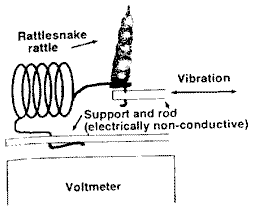 |
Science Frontiers ONLINE No. 96: Nov-Dec 1994 |
|
|
Electric Snakes
We have already written about electric fish and how they employ electrical fields to create an "image" of their environment. (SF#89) Snakes, too, it seems, possess an electrostatic sense.
 The experimental setup for demonstrating the electrostatic-generating capabilities of rattlesnake rattles. |
What is the electrostatic payoff for snakes in their search for prey? It is hard to say. Who has followed hungry snakes around checking on their electric fields? A clue may lie in the ways snakes use their forked tongues in hunting. When following a chemical trail, snakes usually touch surfaces with their flicking tongues. In general exploration, when chemical trails are absent, snakes seem to wave their tongues up and down in a distinctive manner, avoiding surfaces. Herpetologists usually ascribe this action to chemical "sniffing." However, W.T. Vonstille and W.T. Stille, III, venture a different explanation:
"The fact that moist air is conductive for the electric charges that exist on the Earth's surface could be very important to a snake's survival. The airborne plumes of moisture exhaled by animals and flowing out from under cover are invaded by static charges from the Earth and could be detected by snakes."
(Vonstille, W.T., and Stille, W.T., III; "Electrostatic Sense in Rattlesnakes," Nature, 370:184, 1994.)